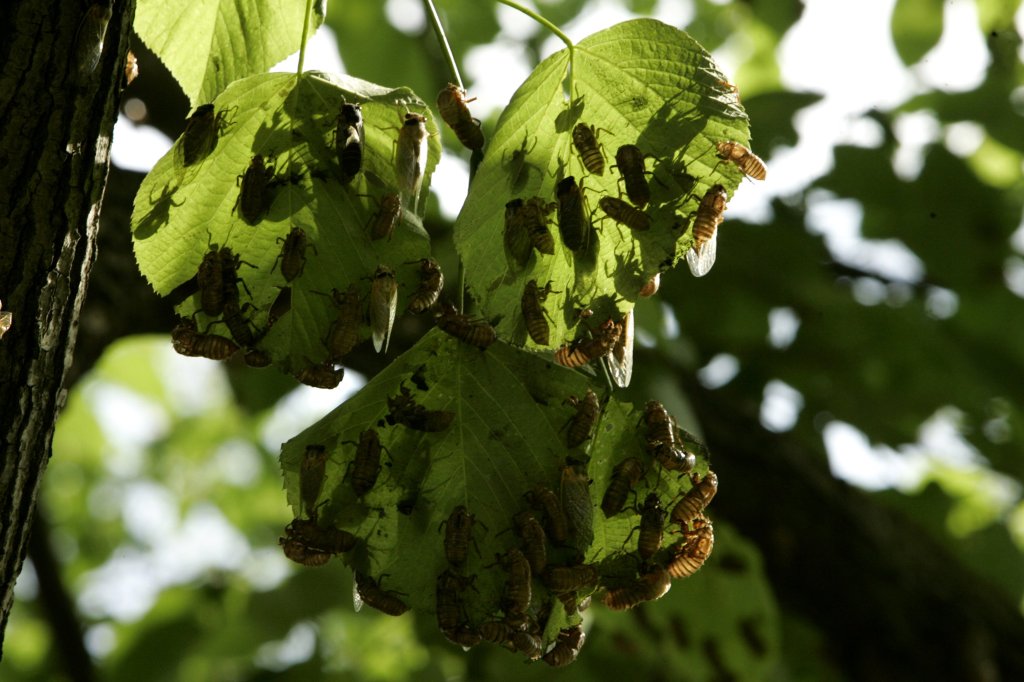They’re here again. Two buzzing broods of cicadas are emerging. Together, the Northern Illinois and the Great Southern broods may result in more than a trillion of these insects rising in the backyards and parks and forest preserves of 17 states. I call it the cicada tornado. And it’s way more interesting than the total eclipse.
While instilling fear and disgust in some, the wild, wonderful plague of tree bugs inspires delight and wonder in others. I find them miraculous: 13 to 17 years spent in darkness underground, followed by a few weeks of passion, of sunlight and sex. What of this imbalance between patience and passion?
I noticed the little exit holes in our flowerbeds recently — the openings to finger-sized mud chimneys. Cicada nymphs are living heat censors, slipping up and down the snug chambers like little pistons, first sampling the air and then retracting back into their loamy sleeves. They keep doing this — testing and retesting the temperature — waiting for the moment when their bodies “know” that the soil has reached 64 degrees, chemically signaling it is time to leave.
I remember the last Northern Illinois brood in late May 2007. I had noticed a dozen or so of the chimneys in our garden but could not imagine what was coming — the winged legions lurking below, all about to crawl out of the ground, to molt from nymphs into adults.
I watched their soft, white bodies harden and darken as they opened their wings and crept up the forsythia and the maple and elm trees that lined our yard. In their wake, they left brown shells clinging to the bark and leaves like a snapshot of their transformation.
And it all happened in two weeks — our backyard transformed into a great cloud of sound, of chaos. At the time, a biologist friend told me that there could be up to a million per acre. I calculated that meant there were perhaps 300,000 in our backyard. Each night, I would sit outside and listen to the newest arrivals move through the grass and leaves: platoons of red-eyed soldiers crunching over thousands of their own brittle casings. Then up the trees they would march to wait for the sun and sing for a mate.
On a bright clear day, the waves of sound from the male cicadas were deafening. The droning can reach 95 decibels, at which point audiologists suggest going indoors to avoid hearing damage. Once, while I was mowing the lawn, hundreds of them started dive-bombing me, landing on my clothing and the mower. A few days later, I realized that they were females attracted to the blare of the mower. To them the mower was saying the same things the male cicadas were: “Have sex with me!” “No, have sex with me!” “No, me!”
The other animals in our yard cared less about mating than eating. When the cicadas arrived, the cardinals, sparrows and blue jays left the birdfeeder untouched and instead gorged themselves on the plump delicacies. The backyard was a smorgasbord for creatures from dogs and raccoons to chipmunks. Even people viewed the cicada as an short-lived cuisine. Most recipes for cicadas involve boiling or frying them, then stirring them in “to taste.”
They have a nutty flavor. I tried cicada oatmeal cookies at a neighbor’s picnic, where I heard about a few other recipes: curried cicada and chickpeas, cicada portobello quiche and German chocolate cicada cake.
I recall a local TV news station ran a lead-in feature titled “The Passion of the Cicada.” It focused on the physical transformation, the mating songs and egg laying, on that tiny fraction of the cicada’s life we can hear and see. I found myself wondering about the part we can’t see — the patience of the cicada, the 99% of its life spent waiting to emerge.
According to the news story, the seeming imbalance between patience and passion in the cicada’s life is useful. The cyclical emergence of the cicada — 13 or 17 years — was an adaptation to overwhelm their predators, who simply can’t eat them all, and to confound the shorter life cycles of other predators. The patience and passion have a purpose and have worked for a very long time. Fossil records suggest cicada species have been around for a hundred million years.
Given the immense patience of the cicadas, it seems that Homo sapiens — a much younger and more fragile species — might also be patient with them during their short visit to our backyards this summer. After all, they don’t bite or sting or destroy our gardens.
And in addition to feeding the birds and wildlife, their holes aerate the soil and improve water filtration in our yards. And when they rot and decompose, they add nutrients to the soil, serving as a natural fertilizer.
So while everyone will not celebrate or welcome these ancient relatives, hopefully everyone will learn to tolerate them.
Tom Montgomery Fate is an emeritus professor at College of DuPage and teaches part time at the University of St. Francis in Joliet. His most recent book is “The Long Way Home,” a collection of essays.
Submit a letter, of no more than 400 words, to the editor here or email letters@chicagotribune.com.


